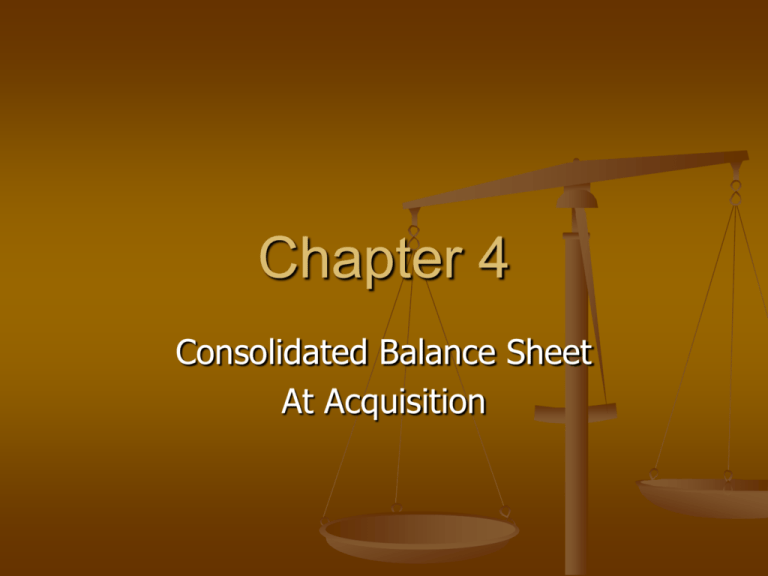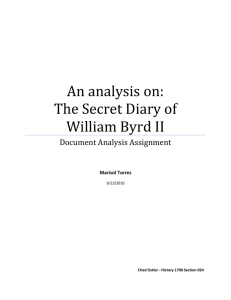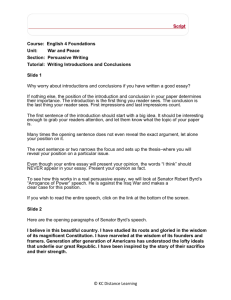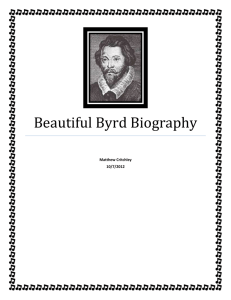Chapter 4
advertisement

Chapter 4 Consolidated Balance Sheet At Acquisition The Objective Of Consolidation Sub A Parent Sub B Parent And Subs As If One Entity Therefore One Set Of Financial Statements © 2009 Clarence Byrd Inc. 2 User Needs Creditors Consolidated Entity ≠ Legal Entity Creditors must look to single entity parent or subsidiary © 2009 Clarence Byrd Inc. 3 User Needs Taxation Authorities U.S. has consolidated tax return In Canada – the single legal entities must file therefore the consolidated statement is essentially ignored © 2009 Clarence Byrd Inc. 4 User Needs Non-Controlling Shareholders Must look to single entity statements to evaluate their investment © 2009 Clarence Byrd Inc. 5 User Needs Majority Shareholders The major users of consolidated financial statements © 2009 Clarence Byrd Inc. 6 Consolidation Policy © 2009 Clarence Byrd Inc. 7 Terminology The “correct” term is “Non-Controlling Interest” Control may not required holding a majority share of voting shares. Consolidation is still required “Minority Interest” is still widely used In most cases, control requires a majority of the voting shares In these situations, Minority Interest is an appropriate description of the Non-Controlling Interest © 2009 Clarence Byrd Inc. 8 Conceptual Alternatives In Consolidation Controlling Interest Non-Controlling Interest What Is The Nature Of This Interest? © 2009 Clarence Byrd Inc. 9 Conceptual Alternatives In Consolidation Entity Approach The Non-Controlling Interest is an equity interest in the consolidated entity. Differs from controlling only in terms of size. Section 1582: Entity is one of the acceptable choices) © 2009 Clarence Byrd Inc. 10 Entity Approach Procedures Assets: Includes 100 percent of subsidiary fair values (Identifiable assets and goodwill) Non-controlling interest In assets: With shareholders’ equity In income: Shown as distribution of income (like preferred dividends) on the Statement of Retained Earnings Unrealized Profits: Eliminate 100 percent (upstream and downstream) © 2009 Clarence Byrd Inc. 11 Conceptual Alternatives In Consolidation Proprietary Approach The Non-Controlling Interest is not part of the consolidated entity Like proportionate consolidation © 2009 Clarence Byrd Inc. 12 Proprietary Approach Procedures Assets: Only the parent’s share of identifiable assets and goodwill Non-controlling interest In assets: None disclosed In income: None disclosed Unrealized Profits: Eliminate parent’s share © 2009 Clarence Byrd Inc. 13 Conceptual Alternatives In Consolidation Parent Company Approach The Non-Controlling Interest is a debt-like interest in the consolidated entity The old CICA approach. © 2009 Clarence Byrd Inc. 14 Parent Company Approach Procedures Assets: Includes 100% of subsidiary carrying values, plus the parent’s share of fair value changes Non-controlling interest In assets: With the long-term liabilities In income: Deducted in the determination of income (like interest) Unrealized Profits: Eliminate parent’s share © 2009 Clarence Byrd Inc. 15 Conceptual Alternatives In Consolidation Why Study? Aids in understanding the current rules and their inconsistencies Will assist with the changeover to IFRSs (will use two different approaches) For Students: It can be examinable – Sections 1582, 1601 and 1602 will be the focus of the text © 2009 Clarence Byrd Inc. 16 Conceptual Alternatives Under Section 1582 (And IFRS 3) Provides For Alternative Measures Alternative 1 NCI = Proportionate share of the fair value of the Identifiable Net Assets of Subsidiary © 2009 Clarence Byrd Inc. This approach recognizes 100 percent of the fair values of identifiable assets, but only the parent’s share of goodwill (not a consistent appraoch) 17 Conceptual Alternatives Under Section 1582 (And IFRS 3) Provides For Alternative Measures Alternative 2 NCI based on its fair value measured directly or based on investment cost © 2009 Clarence Byrd Inc. This approach recognizes 100 percent of the fair values of identifiable assets and 100 percent of goodwill (Entity Approach) 18 Procedural Approaches Every text has a different approach Everyone who has ever taught the subject believes that they have a better way Difficult to move between alternatives © 2009 Clarence Byrd Inc. 19 Procedural Approaches Work Sheets A mechanistic approach that is easy to use, provided a proper format is provided Provides no understanding of the underlying concepts In our view: Consolidations for “Dummies” © 2009 Clarence Byrd Inc. 20 Procedural Alternatives Direct Calculations Of Required Balances The most efficient approach Requires complete understanding of concepts Consolidations for the “gifted” © 2009 Clarence Byrd Inc. 21 Procedural Alternatives Journal Entries into direct calculations Stresses an understanding of concepts Provides for movement towards direct calculations of required balances Is not dependent on the format of the problem Supported by a large quantity of problem material in this text © 2009 Clarence Byrd Inc. 22 General Approach Eliminate the investment account against the subsidiary Shareholders’ Equity at time of acquisition Allocate the excess of the investment cost over the carrying values of the subsidiary assets to fair value changes and goodwill Establish the Non-Controlling Interest At Acquisition © 2009 Clarence Byrd Inc. 23 General Approach Various adjustments and eliminations Only intercompany asset eliminations in this chapter Others in chapters 5 and 6 © 2009 Clarence Byrd Inc. 24 General Approach Allocate the subsidiary’s Retained Earnings since acquisition To Controlling Interest To Non-Controlling Interest © 2009 Clarence Byrd Inc. 25 Investment Analysis Schedule Example Investment Cost Add: Non-controlling interest (Two Alternative Approaches)) Subtotal Less: Fair Value of Subsidiary Net Identifiable Assets Goodwill $1,000,000 200,000 $1,200,000 1,000,000 $ 200,000 This type of analysis is required in almost every consolidation problem. The basic rules are as shown in this example. The numbers were created for this example. © 2009 Clarence Byrd Inc. 26 Example – Consolidation At Acquisition Parco purchases 80 percent of the outstanding voting shares of Subco for cash of $2,000,000. Subco’s identifiable assets have a fair value of $1,800,000 (net fair value equals $1,000,000). Parco Subco Assets $3,500,000 $2,000,000 Liabilities $1,300,000 $ 800,000 900,000 200,000 1,300,000 1,000,000 $3,500,000 $2,000,000 Shareholders’ Equity Common Stock Retained Earnings Total Equities © 2009 Clarence Byrd Inc. 27 Example – Investment Analysis Schedule – based on identifiable net assets Investment Cost (Consideration transferred) Non-Controlling interest (20% of $1,000,000) Subtotal Less: Fair Value of Subco’s Identifiable net assets Goodwill © 2009 Clarence Byrd Inc. $2,000,000 200,000 $2,200,000 1,000,000 $1,200,000 28 Example – Investment Analysis Schedule – based on fair value Investment Cost (Consideration transferred) Non-Controlling interest (20%)($2,000,000/80%) Subtotal Less: Fair Value of Subco’s Identifiable assets Goodwill © 2009 Clarence Byrd Inc. $2,000,000 500,000 $2,500,000 1,000,000 $1,500,000 29 Consolidated Balance Sheet NCI On Identifiable Assets Assets ($3,500,000 - $2,000,000 + $1,800,000) Goodwill $3,300,000 1,200,000 Total Assets $4,500,000 Liabilities Regular ($1,300,000 + $800,000) $2,100,000 Non-Controlling Interest [(20%)($1,000,000)] Total Liabilities 200,000 $2,300,000 Shareholders’ Equity Common Stock (Parco’s) Retained Earnings (Parco’s) Total Equities © 2009 Clarence Byrd Inc. 900,000 1,300,000 $4,500,000 30 Consolidated Balance Sheet NCI On Fair Value Assets ($3,500,000 - $2,000,000 + $1,800,000) Goodwill $3,300,000 1,500,000 Total Assets $4,800,000 Liabilities ($1,300,000 + $800,000) $2,100,000 Shareholders’ Equity Non-Controlling Interest [(20%)($2,000,000/80%)] 500,000 Common Stock (Parco’s) 900,000 Retained Earnings (Parco’s) Total Equities © 2009 Clarence Byrd Inc. 1,300,000 $4,800,000 31 International Convergence Chapter 4 based on Section 1582, 1601, 1602 These sections are consistent with IFRS No. 3 and IAS No. 27 © 2009 Clarence Byrd Inc. 32 Summary Of Chapter 4 Procedures Step A-1 Procedure Eliminate 100 percent of the Investment In Subsidiary account. Step A-2 Procedure Eliminate 100 percent of all the acquisition date balances in the subsidiary’s common shareholders’ equity (includes both contributed capital and retained earnings). Step A-3 Procedure Allocate any debit or credit Differential to 100 percent of the fair value changes on identifiable assets, 100 percent of the fair value changes on identifiable liabilities, and Goodwill (or a Bargain Purchase Gain). The amount allocated to Goodwill is dependent on the measurement used for non-controlling interest. Step A-4 Procedure Record Non-Controlling interest at the time of acquisition. Depending on management’s choice, the amount to be recorded will be either the non-controlling interest’s share of the fair value of the subsidiary’s net identifiable assets or, alternatively, the fair value of the non-controlling interest. Step B-1 Procedure Eliminate 100 percent of all intercompany assets and liabilities. © 2009 Clarence Byrd Inc. 33 Definitional Calculations Identifiable Assets And Liabilities The amount to be included in the consolidated Balance Sheet for any identifiable asset or liability is calculated as follows: 100 percent of the carrying value of the identifiable asset (liability) on the books of the parent company at the Balance Sheet date; plus 100 percent of the carrying value of the identifiable asset (liability) on the books of the subsidiary company at the Balance Sheet date; plus (minus) 100 percent of the fair value increases (decreases) on the identifiable assets (liabilities) of the subsidiary company at the Balance Sheet date. © 2009 Clarence Byrd Inc. 34 Definitional Calculations Goodwill (Bargain Purchase Gain) The Goodwill to be recorded in the consolidated balance sheet is equal to: The sum of the consideration transferred (investment cost) plus the measured value of Non-Controlling Interest; less The fair value of the identifiable net assets of the subsidiary Non-Controlling Interest - Balance Sheet – there are 2 alternatives: The Non-Controlling Interest can be based on the noncontrolling shareholders’ percentage interest in the fair value of the identifiable net assets in the subsidiary The Non-Controlling Interest can be based on the fair value of the non-controlling shareholders’ interest in the enterprise. The estimate of this value can be based on the fair value of the controlling interest as measured by the investment cost or, alternatively, through some form of separate measurement © 2009 Clarence Byrd Inc. 35 Definitional Calculations Contributed Capital The Contributed Capital to be recorded in the consolidated Balance Sheet is equal to the contributed capital from the single entity Balance Sheet of the parent company. Retained Earnings Consolidated Retained Earnings will be equal to the Retained Earnings balance that is included in the Balance Sheet of the parent company. © 2009 Clarence Byrd Inc. 36 © 2009 Clarence Byrd Inc. 37






